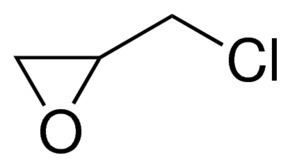Appearance colorless liquid Formula C3H5ClO Molar mass 92.52 g/mol | Density 1.18 g/cm³ Boiling point 117.9 °C Melting point -25.6 °C | |
 | ||
Epichlorohydrin (abbreviated ECH) is an organochlorine compound and an epoxide. Despite its name, it is not a halohydrin. It is a colorless liquid with a pungent, garlic-like odor, moderately soluble in water, but miscible with most polar organic solvents. It is a chiral molecule generally existing as a racemic mixture of right-handed and left-handed enantiomers. Epichlorohydrin is a highly reactive compound and is used in the production of glycerol, plastics, epoxy glues and resins, and elastomers. In contact with water, epichlorohydrin hydrolyzes to 3-MCPD, a carcinogen found in food.
Contents
Production
Epichlorohydrin was first described in 1848 by Marcellin Berthelot. The compound was isolated during studies on reactions between glycerol and gaseous hydrogen chloride.
Epichlorohydrin is manufactured from allyl chloride in two steps, beginning with the addition of hypochlorous acid, which affords a mixture of two alcohols:
CH2=CHCH2Cl + HOCl → HOCH2CHClCH2Cl and, or ClCH2CH(OH)CH2ClIn the second step, this mixture is treated with base to give the epoxide:
In this way, more than 800,000 tons (1997) of epichlorohydrin are produced annually.
From glycerol
Glycerol is a co-product of biodiesel produced on a large scale. The conversion of glycerol into other building block chemicals is of interest because glycerol is otherwise hard to dispose of. Dow and Solvay are building glycerol-to-epichlorohydrin (GTE) plants in Shanghai and Thailand, respectively. In Dow's process, glycerol is dichlorinated with hydrogen chloride with the help of a carboxylic acid catalyst. The mixture of dichlorohydroxypropanes is treated with base to form epichlorohydrin.
Glycerol and epoxy resins synthesis
Epichlorohydrin is mainly converted to bisphenol A diglycidyl ether, a building block in the manufacture of epoxy resins. It is also a precursor to monomers for other resins and polymers. Another usage is the conversion to synthetic glycerol:
CH2CHOCH2Cl + 2 H2O → HOCH2CH(OH)CH2(OH) + HClHowever, the rapid increase in biodiesel production, where glycerol is a waste product, has led to a glut of glycerol on the market, rendering this process uneconomic for the mass market. Synthetic glycerol is now used only in sensitive pharmaceutical, technical and personal care applications where quality standards are very high.
Minor and niche applications
Epichlorohydrin is a versatile precursor in the synthesis of many organic compounds. For example, it is converted to glycidyl nitrate, an energetic binder used in explosive and propellant compositions. The epichlorohydrin is reacted with an alkali nitrate, such as sodium nitrate, producing glycidyl nitrate and alkali chloride. It is used as a solvent for cellulose, resins, and paints, and it has found use as an insect fumigant.
Polymers made from epichlorohydrin, e.g., polyamide-epichlorohydrin resins, are used in paper reinforcement and in the food industry to manufacture tea bags, coffee filters, and sausage/salami casings as well as with water purification.
An important biochemical application of epichlorohydrin is its use as crosslinking agent for the production of Sephadex size-exclusion chromatographic resins from dextrans.
Safety
Epichlorohydrin is classified by several international health research agencies and groups as a probable or likely human carcinogen in humans. Prolonged oral consumption of high levels of epichlorohydrin could result in stomach problems and an increased risk of cancer. Occupational exposure to epichlorohydrin via inhalation could result in lung irritation and an increased risk of lung cancer.
